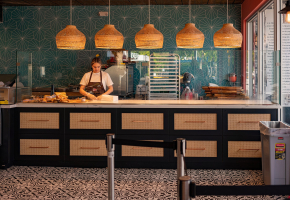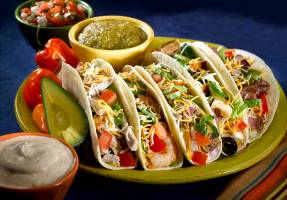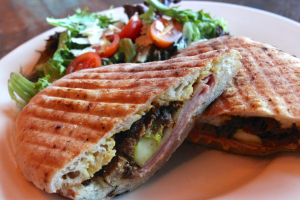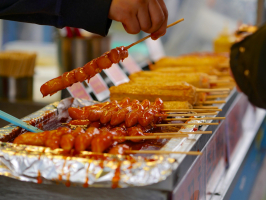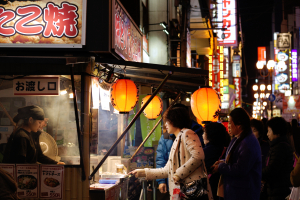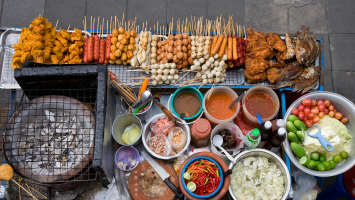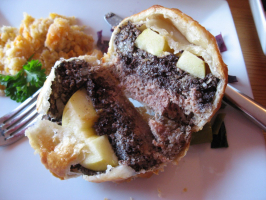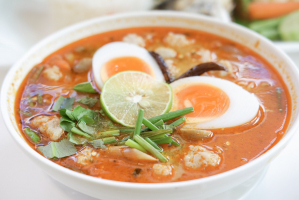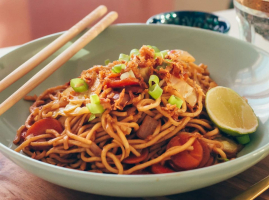Top 10 Best Beijing Street Food
Beijing street food is a vibrant tapestry of flavors and traditions. These iconic delights offer a journey through the city's rich culinary heritage in every ... read more...bite. Toplist has carefully curated a list of the best Beijing street foods.
-
Tanghulu ranked as a top favorite of Beijing's streets. This iconic snack is known in Mandarin as "糖葫芦." It embodies simplicity and wonder. Picture skewered hawthorn berries glistening with a crispy sugar shell. When that sugary syrup solidifies around the berries, it creates a delightful contrast in textures.
The vibrant red hawthorn berries used in Tanghulu have been a part of Chinese culture for ages. Their sweet-tart flavor contrasts beautifully with the crispy, sugary shell. But beyond its taste, Tanghulu has deep roots in Beijing's history.
Its origins trace back centuries and are intertwined with tales of ancient Beijing's frosty winters. The treat became a way for locals to enjoy preserved fruit during colder months. Over the years, it's not just a winter treat but an all-year-round delicacy.
Paired with its history is Tanghulu's significant cultural presence. The treat often makes an appearance during festivals and special events. It symbolizes sweetness and togetherness. Its bright colors and shiny appearance have made it a symbol of joy and celebration.
Despite its age-old traditions, Tanghulu isn't restricted to hawthorn berries. Modern variations have included strawberries, kiwi, and even grapes. These contemporary twists cater to a wider audience. In addition, whether you're a vegan or someone with a sweet tooth, there's a Tanghulu for you. Some vendors even offer versions with a chocolate or nutty coating, a testament to Tanghulu's enduring appeal with the times.
Moving to its preparation, making Tanghulu is an art. The sugar needs to be heated to just the right temperature. Too hot, and it will caramelize; too cold, and it won't form the desired crisp shell. The skewered fruits are then dipped in the sugar syrup and left to cool. It resulted in the iconic crispy texture.
Locals have a deep love for Tanghulu. Ask anyone from Beijing, and they'll have a Tanghulu story to share. Whether it's memories of buying one from a street vendor or enjoying it at a local festival, Tanghulu holds a special place in many hearts.
Key Takeaways:
- Origin: Ancient Beijing.
- Primary Flavors: Mix of sweet and tart.
- Typical Consumption Time: All year round, especially during festivals.
- Modern Evolution: Beyond hawthorn berries, now includes strawberries, kiwis, and more.
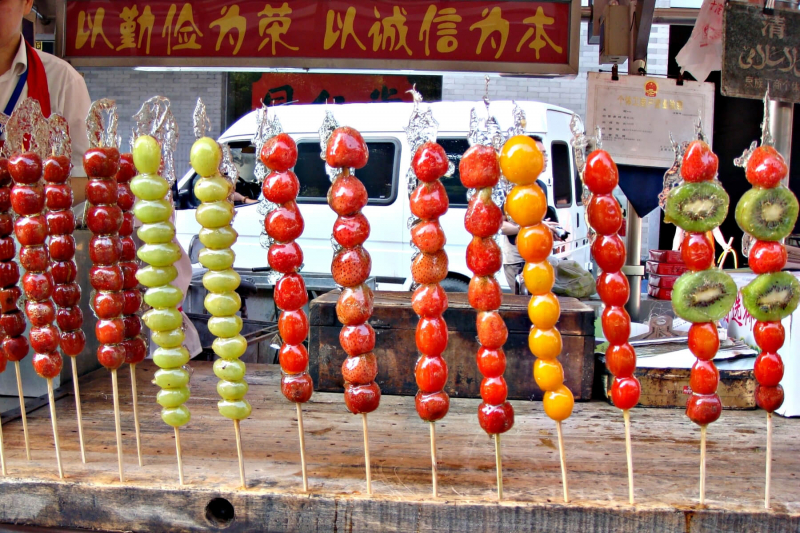
Screenshot of https://en.wikipedia.org/wiki/Tanghulu Video by Soon Films 순필름 -
Jianbing ranks high among Beijing's street foods. Known as 煎饼 in Mandarin, this savory crepe captures the essence of traditional Chinese breakfasts. Imagine a thin, freshly made crepe, filled with an array of textures and flavors. From the egg spread on its surface to the crisp fried cracker inside, each bite offers a delightful experience.
The origins of Jianbing trace back over 2,000 years. Soldiers who, without pots, used their shields to cook batter, created the first Jianbing. It stood the test of time. As it transitioned from a makeshift meal to a breakfast staple in Beijing's bustling streets.
Its popularity isn't accidental. The blend of textures in Jianbing is an art. The softness of the crepe contrasts with the crunchy cracker. Add in the savory sauces, and it’s clear why this dish has stolen many hearts. It's customizable too with fillings ranging from spicy pickles to sausages. As a result, it allows eaters to personalize their Jianbing experience.
In today's modern Beijing, Jianbing isn’t only a breakfast treat. It's a snack people crave any time of day. Street vendors serve it fresh, with queues forming early morning and continuing into the night. Its preparation, often visible to customers, adds an element of theater. The quick spreading of the batter, the egg layer, and the swift addition of fillings showcase a chef's skill.
Jianbing has also seen innovative twists in recent years. Some vendors introduce unconventional fillings, like cheese or ham. Others play with the sauces, offering sweeter or spicier versions. These modern renditions ensure Jianbing stays relevant and exciting to younger generations.
For locals, Jianbing isn't just food; it's nostalgia. It reminds many of hurried breakfasts before school or late-night snacks after an evening out. It embodies the soul of Beijing: a mix of tradition and modernity.
Key Takeaways:
- Origin: Shandong Province.
- Primary Flavors: Savory with hints of spiciness.
- Typical Consumption Time: Breakfast.
- Modern Evolution: Contemporary twists include fillings such as ham, cheese, and even chocolate. Flavors have expanded to incorporate spicy, barbecue, and teriyaki sauces.
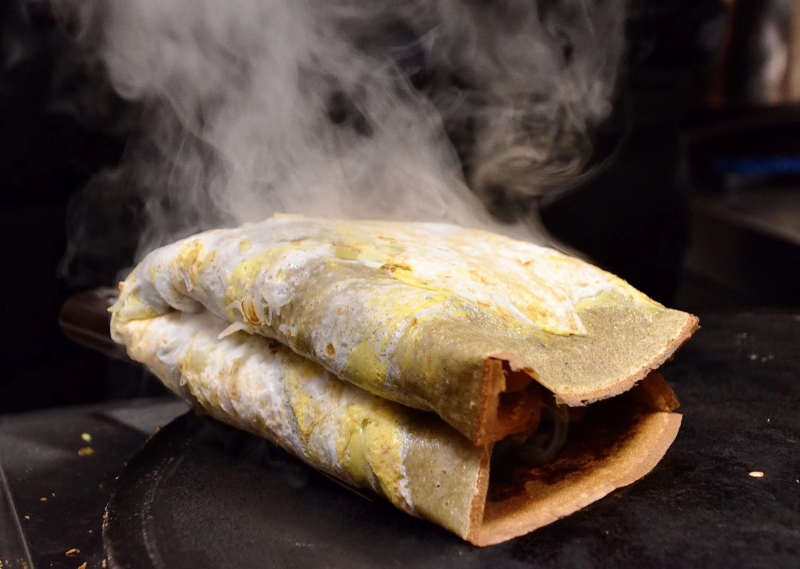
Screenshot of https://en.wikipedia.org/wiki/Jianbing Video by Travel Thirsty -
Baozi is a shining star in Beijing's culinary universe. When you hear "包子" in the bustling streets of Beijing, you're being invited to savor a piece of China's rich culinary heritage. At its core, Baozi is a steamed bun. It's a bundle of flavors and textures, wrapped in a soft, fluffy casing.
The beauty of Baozi lies in its versatility. These buns can be stuffed with a plethora of fillings: from savory meats like pork and beef to sweet red bean paste. Every Baozi bite is a surprise, waiting to unveil its hidden treasures. This versatility stems from ancient China. Historians believe that Baozi dates back to the Three Kingdoms period. Its long-standing presence is a testament to its beloved status among Chinese people.
In the streets of Beijing, Baozi vendors are a common sight. From dawn to dusk, they serve these buns piping hot, right out of the steamer. The steam rising from the buns in the cold Beijing air is a sight many hold dear. Locals often pair Baozi with tea. This pair makes a complete, hearty meal. For many, it's the perfect start to a day.
With changing times, Baozi has seen many adaptations. While traditional fillings remain popular, new-age flavors have also found their way inside these buns. Think of exotic mushrooms, spicy tofu, or even chocolate! These innovations keep Baozi relevant to every generation.
Baozi preparation is a craft. Making the perfect dough, ensuring it's neither too thick nor too thin, is crucial. The fillings, often made a day in advance, need to be flavorful and cooked to perfection. When these elements come together, magic happens. That magic is a soft bun, with a flavorful center.
For Beijing's denizens, Baozi is more than food. It's a memory. It's the comfort of a warm bun on a cold day. It's the joy of sharing a meal with loved ones. And above all, it's a piece of Beijing's heart, served on a plate.
Key Takeaways:
- Origin: Ancient China.
- Primary Flavors: Can be either savory or sweet, depending on the filling.
- Typical Consumption Time: Breakfast or lunch..
- Modern Evolution: Mozzarella cheese, Nutella, and even matcha-flavored custard.
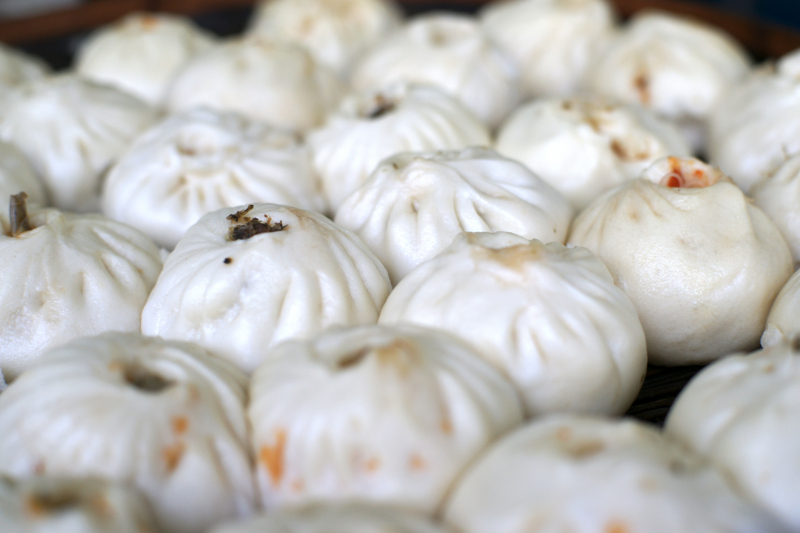
Screenshot of https://en.wikipedia.org/wiki/Baozi 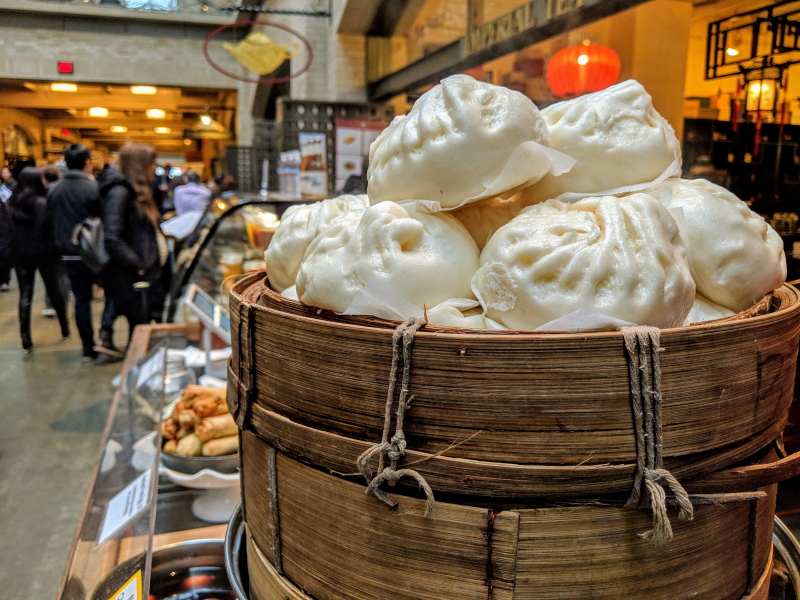
Photo on PxHere https://pxhere.com/zh/photo/1576669 -
Youtiao, Beijing's morning favorite, needs little introduction. As the morning sun casts its first light on Beijing's streets, the aroma of freshly fried Youtiao, or "油条," beckons locals and tourists alike. This golden, crispy treat is China's answer to the Western donut, but with its unique spin.
Often described as a "Chinese cruller," Youtiao is a long, deep-fried strip of dough. Its exterior is crunchy, while the inside remains soft and airy. Every balance of textures makes it a joy to savor. Dipping it in soy milk or porridge enhances its taste, and offers a blend of flavors that dance on the palate.
The origins of Youtiao go way back in Chinese history. Legend links it to the Song Dynasty, associating the snack with a form of protest against two traitorous officials. Today, this story adds an intriguing layer to Youtiao.
Making Youtiao is both art and science. The dough requires precise ingredients, mixed in the right order. Once prepared, it's left to rest. This resting period is crucial. It ensures the dough rises, resulting in the Youtiao's signature lightness. When frying, the temperature of the oil matters. Too hot or too cold, and the Youtiao won't achieve its iconic golden hue.
Modern-day Beijing has seen Youtiao evolve. While the classic version remains a favorite, new variants have emerged. Some stalls sprinkle it with sesame seeds, while others fill it with red bean paste or even custard. These innovations cater to the younger generation.
But it's not just the taste that endears Youtiao to many. It's an experience. Watching vendors skillfully shape and fry the dough is mesmerizing. Enjoying a freshly made Youtiao, with steam still rising from it, on a chilly Beijing morning is a memory many cherish.
Key Takeaways:
- Origin: Ancient China.
- Primary Flavors: Crunchy outside, soft inside, with a mildly salty taste.
- Typical Consumption Time: Breakfast, often paired with soy milk or porridge.
- Modern Evolution: Fillings like coconut custard, chocolate sauce, or even durian paste.
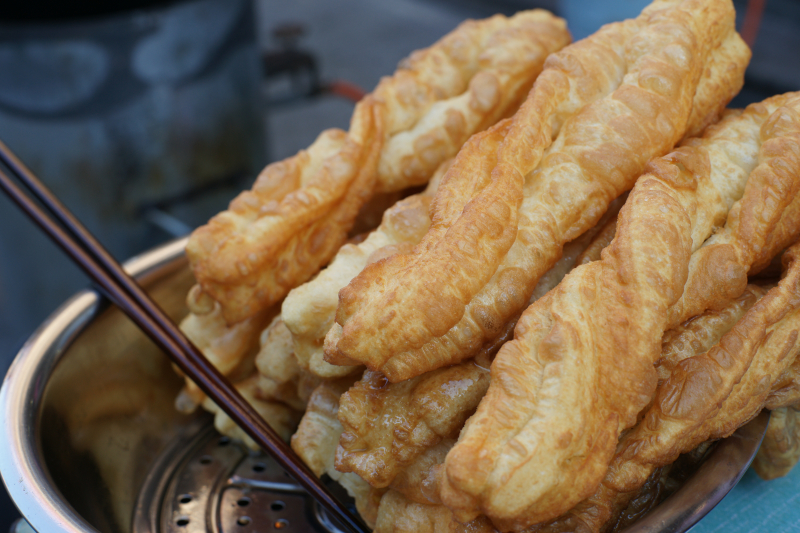
Screenshot of https://en.wikipedia.org/wiki/Youtiao Video by Abaum Veemache -
Stinky Tofu, the name itself, evokes strong reactions. Venturing into Beijing's bustling streets, you'll soon encounter the unmistakable aroma of "臭豆腐". Love it or loathe it, there's no middle ground with this dish. And yet, it reigns supreme among Beijing's many culinary delights.
Originating from the Qing Dynasty, Stinky Tofu has an enthralling past. Its inception was an accident. Legend says a tofu vendor left a batch of tofu outside for days. It turned green and pungent. But when he tasted it, the flavor surprised him. Fast forward to today, and this accidental dish is a Beijing favorite.
Visually, Stinky Tofu is deep-fried to golden perfection. But its hallmark is the smell. The odor comes from fermentation. Tofu cubes are soaked in a brine made from fermented milk, vegetables, and meat. This process can last for days or even months. The longer the fermentation, the stronger the aroma.
But why the widespread adoration for a snack that smells so strong? The magic lies in its taste. The exterior is crispy. Inside, it's soft and flavorful. The fermentation imbues the tofu with a distinct tang, contrasting with its crunchy shell. Most locals dip it in chili sauce or soy sauce, heightening its taste.
Modern variations of Stinky Tofu cater to evolving palates. Some stalls offer a non-fried version, preferring to braise or steam it. Others innovate with toppings, adding pickled vegetables or spicy condiments. These tweaks showcase the dish's versatility, appealing to both traditionalists and new fans.
For first-timers, Stinky Tofu might be a culinary challenge. But those who brave the initial smell are often rewarded with a flavor sensation. In Beijing's food scene, it stands as a testament to the idea that sometimes, you need to look (or smell) beyond the surface to discover true greatness.
Key Takeaways:
- Origin: Ancient China.
- Primary Flavors: Crispy on the outside, soft inside, with a unique fermented tang.
- Typical Consumption Time: Snack or side dish.
- Modern Evolution: Deep-fried versions served with chili sauce or cheese toppings, and some stalls even offer a wasabi variant.
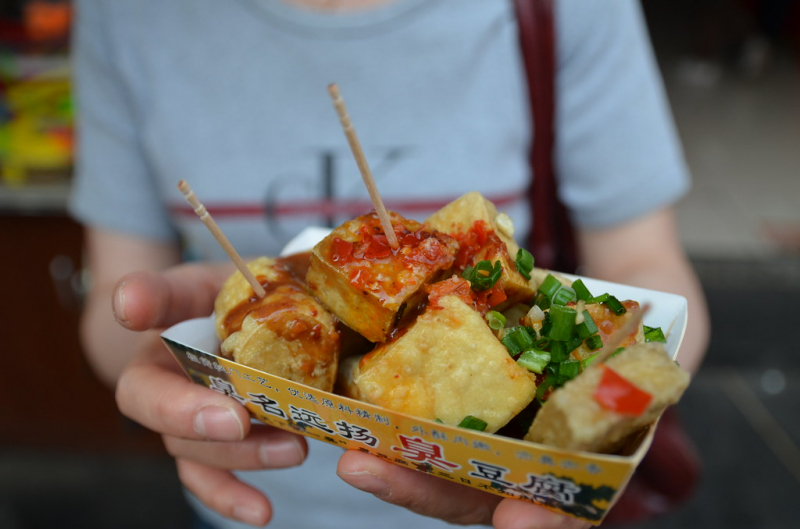
Photo by Josephine Lim on Flickr https://www.flickr.com/photos/josephine_lim/6797591200 Video by ARTGER -
Amidst the vast culinary landscape of Beijing, Roujiamo (肉夹馍) stands tall. Often hailed as the "Chinese hamburger," this sandwich brings together tender, spiced meat tucked inside a freshly baked bun. But labeling it a mere 'hamburger' doesn't do justice to its rich lineage.
Roujiamo finds its roots in the Shaanxi Province. Historians believe it's been nourishing locals for over 2,000 years. That's millennia of perfected recipes! Traditionally, chefs use stewed pork, but variations like beef or lamb are common. The meat, simmered for hours in a concoction of spices, becomes succulent and flavorful. It's then minced and placed between the "mo" - a flat, crispy bread. The result? A bite that's both hearty and historically rich.
If you were to walk the streets of Beijing, you'd notice various street vendors. And each offers their unique spin on Roujiamo. Some emphasize the spice blend, using star anise, cinnamon, or cloves. Others focus on the bread, ensuring it's freshly baked and crispy. The best vendors, though, strike a balance between the tender meat and the perfect "mo".
The modern-day Roujiamo caters to contemporary tastes while paying homage to its ancestry. Vegetarian versions have mushroom or tofu as fillings. Some stalls experiment with condiments by adding pickled peppers or a hint of chili oil. The constant reinvention ensures Roujiamo remains relevant and beloved by all age groups.
Locals often pair Roujiamo with a bowl of hot, sour soup to make it a complete meal. It's no wonder then that this ancient snack has stood the test of time. From emperors of yesteryears to today's bustling city dwellers, Roujiamo has been a constant.
Key Takeaways:
- Origin: Shaanxi Province.
- Primary Flavors: Tender, spiced meat balanced by crispy bread.
- Typical Consumption Time: Lunch or dinner.
- Modern Evolution: Spicy chicken, beef with cilantro, and even a mushroom and tofu vegetarian option.
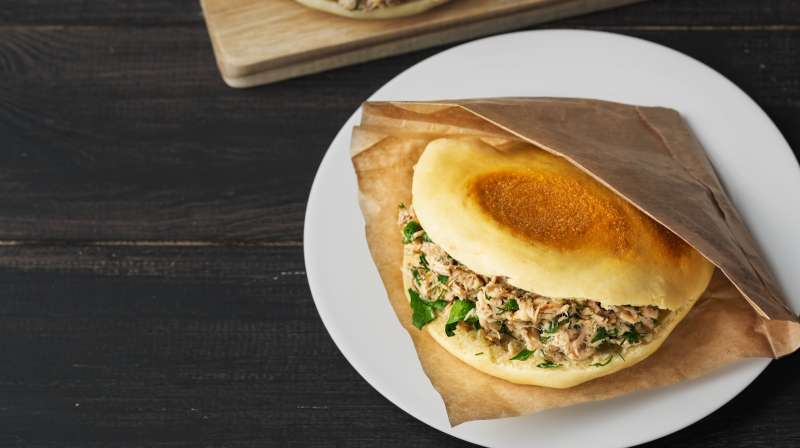
Screenshot of https://en.wikipedia.org/wiki/Roujiamo Video by Travel Thirsty -
Cha Ye Dan (茶叶蛋) is a testament to Beijing's innovative culinary spirit. This snack might sound simple—tea eggs. But delve deeper, and you discover a world of flavor and tradition.
At the heart of Cha Ye Dan lies an ordinary chicken egg. But its preparation elevates it. The eggs are first boiled, and then their shells are lightly cracked. This ensures that the flavors seep into the egg whites. What follows is a bath in a mix of tea leaves, soy sauce, and a cocktail of spices like star anise and cinnamon. The longer the eggs stew in this mixture, the richer their flavor.
Historically, Cha Ye Dan served a dual purpose. While tea-infused food was a delicacy, these eggs also showcased the Chinese philosophy of not wasting food. By reusing tea leaves, cooks found an ingenious way to add flavor to otherwise plain eggs. This thriftiness married with culinary flair gave birth to a beloved snack.
You can't walk through Beijing without noticing street vendors with pots of these marinated eggs. They simmer for hours, ensuring every egg absorbs the flavors fully. The sight of these eggs, with their intricate marbled designs, is a treat for the eyes. Bite into one, and you get a play of textures—the soft egg white, the creamy yolk, and the slightly chewy parts where the flavors have deeply penetrated.
Today's Cha Ye Dan still maintains its traditional essence but has seen a few adaptations. Some vendors add a dash of orange peel or use different tea varieties, from black to green. Each lends a unique flavor. This evolving taste palette ensures Cha Ye Dan appeals to both the young and the old.
While primarily a snack, locals often include Cha Ye Dan in their breakfast, paired with congee or steamed buns. It blends the astringency of tea with the richness of spices. It's an experience—one deeply rooted in Beijing's culinary history.
Key Takeaways:
- Origin: Ancient China.
- Primary Flavors: Savory with tea and spice undertones.
- Typical Consumption Time: Snack.
- Modern Evolution: Green tea eggs, black tea eggs, and even those steeped in herbal infusions with star anise and cinnamon.
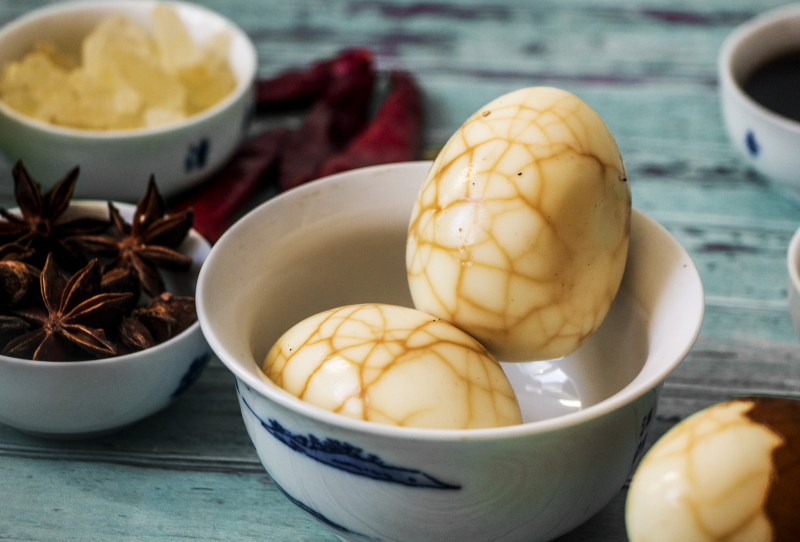
Screenshot of https://en.wikipedia.org/wiki/Tea_egg Video by Make Food. Eat Food. -
Fried Insects (炸昆虫) may raise eyebrows in many parts of the world, but in Beijing, they're a gastronomic delight. Taking a stroll down Beijing's bustling streets, you'll encounter stalls displaying an array of insects, skewered and ready to be fried.
The practice of eating insects isn't a recent trend. China has a history spanning thousands of years of incorporating bugs into its diet. High in protein and low in fat, insects have always been a nutritious option. The crunchy texture and unique taste make them a favorite among locals and daring tourists alike.
Let's talk about selection. From silkworm larvae to scorpions, the variety is staggering. Each insect offers a different taste and texture. For beginners, the grasshopper might be a good start. It has a light, crunchy texture with a nutty flavor. On the other hand, silkworm larvae are creamier, often compared to the consistency of mashed potatoes.
Preparation is key to bringing out the best in these critters. After being cleaned and skewered, they're seasoned. A mix of local spices and herbs coats them. They're then deep-fried to perfection. The result? A crispy exterior that gives way to a tender inside.
For many, the idea of biting into a fried insect can be daunting. But it's the blend of flavors, the crunch, and the novelty that draws people in. Street vendors often serve them with a side of spicy or tangy sauce, amplifying the taste. Eating Fried Insects isn't just about the food. It's about breaking boundaries and exploring the unfamiliar.
Beyond just taste, Fried Insects carry cultural significance. They're not just a survival food or a novelty snack. They represent sustainability and a nod to ancient traditions. As the world looks for sustainable food sources, Beijing's streets offer a solution that's been around for centuries.
Today, as the world becomes more interconnected, Fried Insects have garnered global attention. Food enthusiasts and environmentalists praise their benefits. In Beijing, they remain a testament to the city's ability to blend the old with the new.
Key Takeaways:
- Origin: Various regions across China.
- Primary Flavors: Crunchy and savory, flavor depends on the type of insect and seasoning.
- Typical Consumption Time: Evening snack.
- Modern Evolution: Grasshoppers coated in spicy seasonings, silkworm larvae stir-fried with veggies, and scorpions served with tangy dipping sauces
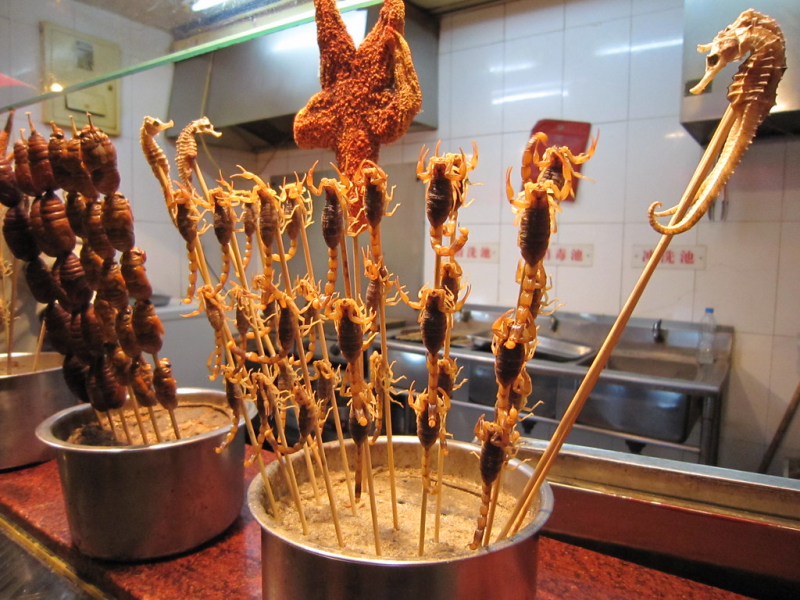
Photo by Felstone on Flickr https://www.flickr.com/photos/felstone/6773375472 Video by Travel Thirsty -
Lamb Skewers, known in Mandarin as "羊肉串," rank as a top favorite in Beijing's street food scene. When the sun goes down, these savory skewers are a familiar sight on Beijing streets. They are a celebration of Beijing's diverse culinary influences.
Originating from China's Xinjiang region, Lamb Skewers have seamlessly integrated into Beijing's food scene. The journey of this dish is a tale of flavors blending and cultures meeting. Traditionally enjoyed by the Hui Muslim community, it has now crossed ethnic boundaries and become a favorite for all.
The magic starts with selecting the right cut of lamb. Tender pieces, usually from the lamb's leg or shoulder, are chosen. These cuts ensure each bite is succulent and melts in the mouth. But it's not just about the meat. The marination plays a pivotal role. A mix of cumin, chili, and other spices are rubbed into the meat. This marination imparts a flavor that's unmistakably intense and rich.
Then comes the grilling. Skewers, laden with marinated lamb pieces, are placed over charcoal. The sizzle of meat on the hot coals and the rising smoke is a sensory delight. As the lamb cooks, it takes on a beautiful golden hue, with bits of char adding to its appeal. The result? Perfectly grilled skewers that are crispy on the outside and tender within.
Gathering around Lamb Skewer stalls is a cherished social ritual. As the sun sets, you'll see families, couples, and friends crowding around these stalls. With a skewer in one hand and maybe a drink in the other, many cherish these moments of togetherness.
Over time, Lamb Skewers have seen various innovations. While the traditional flavors remain beloved, vendors now offer new spice combinations and marinades to cater to evolving tastes. Yet, irrespective of these changes, the core essence of communal joy and culinary delight remains unchanged.
Lamb Skewers are more than just food in Beijing. They are a backdrop for countless memories, be it festive family nights, romantic dates, or cheerful gatherings with friends. They are emotion, resonating with every Beijing local's heart.
Key Takeaways:
- Origin: Xinjiang, China.
- Primary Flavors: Cumin, chili, and local seasonings.
- Typical Consumption Time: Evening or night.
- Modern Evolution: Cumin, paprika, and Sichuan pepper. Some stalls also offer beef, chicken, or even seafood skewers using similar seasonings.
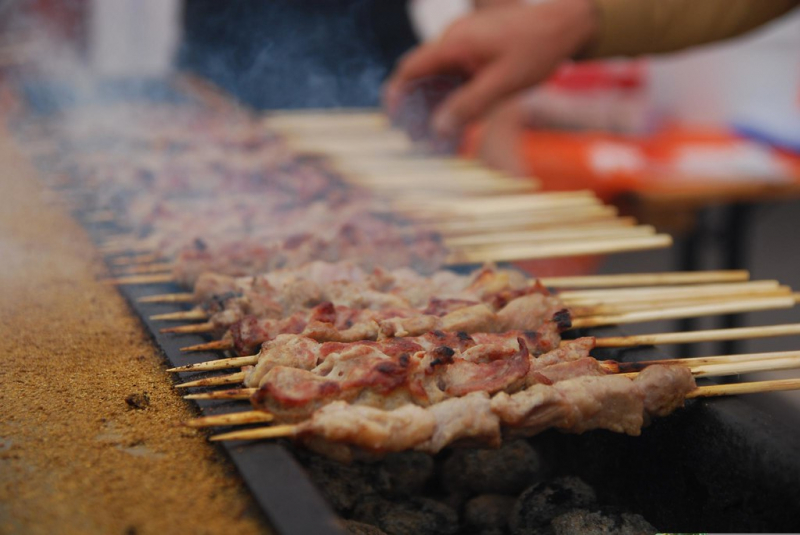
Photo by Alpha on Flickr https://www.flickr.com/photos/avlxyz/5450811456 Video by 曼食慢语 Amanda Tastes -
Stepping into Beijing, one cannot miss the allure of Lao Beijing Suannai. Known as "老北京酸奶" in Mandarin, this traditional yogurt has become a hallmark of Beijing's culinary delights.
Lao Beijing Suannai has its roots deep in the city's history. Centuries ago, locals developed this yogurt using traditional fermentation methods. The process involves boiling milk, letting it cool, then adding old yogurt as a starter. The blend is left overnight. The result? A thick, creamy, and slightly tangy yogurt, unparalleled in taste and texture.
Distinct from regular yogurt, Lao Beijing Suannai is rich and velvety. Often, it's sweetened with sugar or honey to enhance its natural creaminess. You'll typically find it in charming ceramic pots, reflecting age-old traditions. These pots not only keep the yogurt fresh but also give it its iconic look.
Walking the streets of Beijing, it's common to see vendors selling these ceramic pots. Locals often start their mornings with a pot of Suannai. Beyond its delicious flavor, Suannai is a powerhouse of nutrients. It's packed with proteins, vitamins, and probiotics. That makes it a favored choice for a nutritious breakfast or snack.
Over the years, the popularity of Lao Beijing Suannai has soared. Many local shops now infuse flavors, from fruits to nuts. This innovation gives a modern twist to the traditional recipe. While purists prefer the original, the flavored versions have found a fan base among the younger crowd.
Lao Beijing Suannai is more than a tasty treat; it's an embodiment of Beijing's rich history and culture. It connects generations, from grandparents sharing stories of their youth to children experiencing their first taste. This yogurt, with its creamy texture and tangy flavor, holds a special place in the heart of Beijing's residents.
Key Takeaways:
- Origin: Traditional Beijing.
- Primary Flavors: Creamy, thick, and slightly tangy.
- Typical Consumption Time: Breakfast or as a snack.
- Modern Evolution: Suannai with additions like honey, fresh fruit pieces like strawberries and kiwis, or even toppings of granola and nuts.
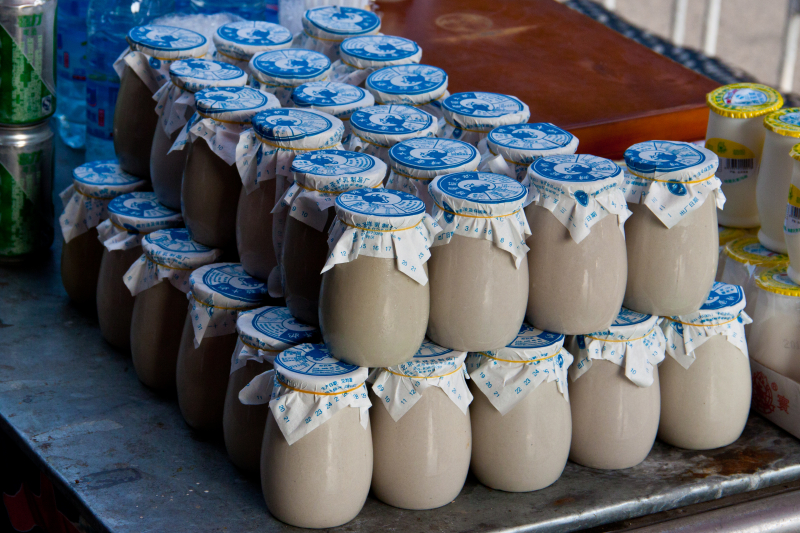
Screenshot of https://en.wikipedia.org/wiki/Nai_lao 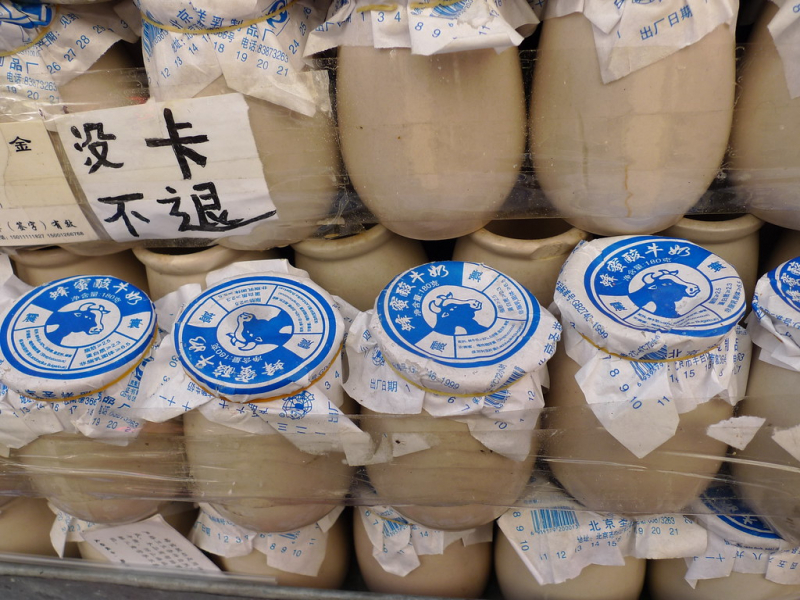
Photo by asiansupper on Flickr https://www.flickr.com/photos/asiansupper/6939038937














